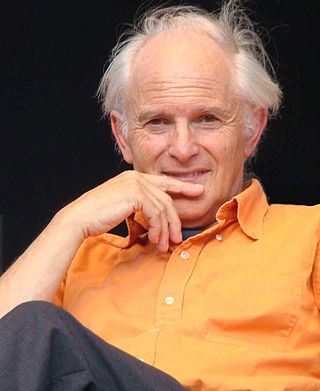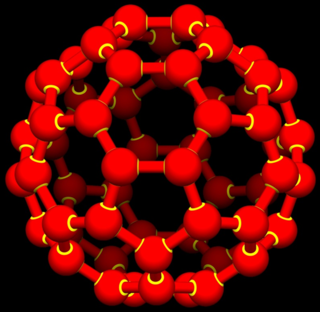Related Research Articles

A fullerene is an allotrope of carbon whose molecules consist of carbon atoms connected by single and double bonds so as to form a closed or partially closed mesh, with fused rings of five to seven atoms. The molecules may have hollow sphere- and ellipsoid-like forms, tubes, or other shapes.

Sir Harold Walter Kroto was an English chemist. He shared the 1996 Nobel Prize in Chemistry with Robert Curl and Richard Smalley for their discovery of fullerenes. He was the recipient of many other honors and awards.

Richard Errett Smalley was an American chemist who was the Gene and Norman Hackerman Professor of Chemistry, Physics, and Astronomy at Rice University. In 1996, along with Robert Curl, also a professor of chemistry at Rice, and Harold Kroto, a professor at the University of Sussex, he was awarded the Nobel Prize in Chemistry for the discovery of a new form of carbon, buckminsterfullerene, also known as buckyballs. He was an advocate of nanotechnology and its applications.

Robert Floyd Curl Jr. was an American chemist who was Pitzer–Schlumberger Professor of Natural Sciences and professor of chemistry at Rice University. He was awarded the Nobel Prize in Chemistry in 1996 for the discovery of the nanomaterial buckminsterfullerene, and hence the fullerene class of materials, along with Richard Smalley and Harold Kroto of the University of Sussex.

Buckminsterfullerene is a type of fullerene with the formula C60. It has a cage-like fused-ring structure (truncated icosahedron) made of twenty hexagons and twelve pentagons, and resembles a football. Each of its 60 carbon atoms is bonded to its three neighbors.
The modularity theorem states that elliptic curves over the field of rational numbers are related to modular forms in a particular way. Andrew Wiles and Richard Taylor proved the modularity theorem for semistable elliptic curves, which was enough to imply Fermat's Last Theorem. Later, a series of papers by Wiles's former students Brian Conrad, Fred Diamond and Richard Taylor, culminating in a joint paper with Christophe Breuil, extended Wiles's techniques to prove the full modularity theorem in 2001.
In complex analysis, de Branges's theorem, or the Bieberbach conjecture, is a theorem that gives a necessary condition on a holomorphic function in order for it to map the open unit disk of the complex plane injectively to the complex plane. It was posed by Ludwig Bieberbach and finally proven by Louis de Branges.
The year 1994 in science and technology involved many significant events, listed below.
The year 1986 in science and technology involved many significant events, some not listed below.

Diffuse interstellar bands (DIBs) are absorption features seen in the spectra of astronomical objects in the Milky Way and other galaxies. They are caused by the absorption of light by the interstellar medium. Circa 500 bands have now been seen, in ultraviolet, visible and infrared wavelengths.
The history of nanotechnology traces the development of the concepts and experimental work falling under the broad category of nanotechnology. Although nanotechnology is a relatively recent development in scientific research, the development of its central concepts happened over a longer period of time. The emergence of nanotechnology in the 1980s was caused by the convergence of experimental advances such as the invention of the scanning tunneling microscope in 1981 and the discovery of fullerenes in 1985, with the elucidation and popularization of a conceptual framework for the goals of nanotechnology beginning with the 1986 publication of the book Engines of Creation. The field was subject to growing public awareness and controversy in the early 2000s, with prominent debates about both its potential implications as well as the feasibility of the applications envisioned by advocates of molecular nanotechnology, and with governments moving to promote and fund research into nanotechnology. The early 2000s also saw the beginnings of commercial applications of nanotechnology, although these were limited to bulk applications of nanomaterials rather than the transformative applications envisioned by the field.

Gerd Binnig is a German physicist. He is most famous for having won the Nobel Prize in Physics jointly with Heinrich Rohrer in 1986 for the invention of the scanning tunneling microscope.
James R. Heath is an American chemist and the president and professor of Institute of Systems Biology. Previous to this, he was the Elizabeth W. Gilloon Professor of Chemistry at the California Institute of Technology, after having moved from University of California Los Angeles.

Christoph Gerber is a Swiss physicist and professor at the University of Basel. He is the co-inventor of the atomic force microscope (AFM), together with Gerd Binnig and Calvin Quate.

In number theory, Fermat's Last Theorem states that no three positive integers a, b, and c satisfy the equation an + bn = cn for any integer value of n greater than 2. The cases n = 1 and n = 2 have been known since antiquity to have infinitely many solutions.
Carbocatalysis is a form of catalysis that uses heterogeneous carbon materials for the transformation or synthesis of organic or inorganic substrates. The catalysts are characterized by their high surface areas, surface functionality, and large, aromatic basal planes. Carbocatalysis can be distinguishable from supported catalysis in that no metal is present, or if metals are present they are not the active species.

C70 fullerene is the fullerene molecule consisting of 70 carbon atoms. It is a cage-like fused-ring structure which resembles a rugby ball, made of 25 hexagons and 12 pentagons, with a carbon atom at the vertices of each polygon and a bond along each polygon edge. A related fullerene molecule, named buckminsterfullerene (or C60 fullerene) consists of 60 carbon atoms.
Azafullerenes are a class of heterofullerenes in which the element substituting for carbon is nitrogen. They can be in the form of a hollow sphere, ellipsoid, tube, and many other shapes. Spherical azafullerenes resemble the balls used in football (soccer). They are also a member of the carbon nitride class of materials that include beta carbon nitride (β-C3N4), predicted to be harder than diamond. Besides the pioneering work of a couple of academic groups, this class of compounds has so far garnered little attention from the broader fullerene research community. Many properties and structures are yet to be discovered for the highly-nitrogen substituted subset of molecules.

Donald R. Huffman (born 1935) is a Professor Emeritus of Physics at the University of Arizona. With Wolfgang Krätschmer, he developed a technique in 1990 for the simple production of large quantities of C60, or Buckminsterfullerene. Previously, in 1982~1983, he and Krätschmer had found, in a UV spectrum, the first signal of C60 ever observed.

Hugo Duminil-Copin is a French mathematician specializing in probability theory. He was awarded the Fields Medal in 2022.
References
- ↑ Kroto, H. W.; Heath, J. R.; O'Brien, S. C.; Curl, R. F.; Smalley, R. E. (1985). "C60: Buckminsterfullerene". Nature . 318 (6042): 162–163. Bibcode:1985Natur.318..162K. doi:10.1038/318162a0. S2CID 4314237.
- ↑ Penguin Pocket On This Day. Penguin Reference Library. 2006. ISBN 978-0-14-102715-9.
- ↑ Farman, J. C.; Gardiner, B. G.; Shanklin, J. D. (1985). "Large losses of total ozone in Antarctica reveal seasonal ClOx/NOx interaction". Nature. 315 (6016): 207–10. Bibcode:1985Natur.315..207F. doi:10.1038/315207a0. S2CID 4346468.
- ↑ Zehr, Stephen C. (1994). "Accounting for the Ozone Hole: Scientific Representations of an Anomaly and Prior Incorrect Claims in Public Settings". The Sociological Quarterly. 35 (4): 603–19. doi:10.1111/j.1533-8525.1994.tb00419.x. JSTOR 4121521.
- ↑ Alfred, Randy (2008-02-09). "Sept. 2, 1985: Hey, Everyone, We Found the Titanic". Wired. Retrieved 2011-11-03.
- ↑ Ballard, Robert D. (December 1985). "How We Found the Titanic". National Geographic . 168 (6): 696–718.
- ↑ de Branges, Louis (1985). "A proof of the Bieberbach conjecture". Acta Mathematica . 154 (1): 137–152. doi: 10.1007/BF02392821 . MR 0772434.
- ↑ Sullivan, Dennis (1985). "Quasiconformal homeomorphisms and dynamics I. Solution of the Fatou-Julia problem on wandering domains". Annals of Mathematics . 122 (2): 401–418. doi:10.2307/1971308. JSTOR 1971308. S2CID 54186648.
- ↑ Adleman L. M.; Heath-Brown, D. R. (June 1985). "The first case of Fermat's last theorem". Inventiones Mathematicae . 79 (2). Berlin: Springer: 409–416. Bibcode:1985InMat..79..409A. doi:10.1007/BF01388981. S2CID 122537472.
- ↑ "Contact – High Technology Lends a Hand/Science of the Soundstage". Warner Bros. Archived from the original on 2001-03-04. Retrieved 2014-09-01.
- ↑ [1985] 3 All ER 402 (HL).
- ↑ "About the Cochrane Library". The Cochrane Library. Archived from the original on 2011-01-05. Retrieved 2011-01-25.
- ↑ Gaines, Larry; Miller, LeRoy (2006). Criminal Justice In Action: The Core. Thomson/Wadsworth. ISBN 978-0-495-00305-2.
- ↑ "Mobiles rack up 20 years of use". BBC News. 2005-01-01. Retrieved 2008-01-29.
- ↑ "UK's first mobile phone user remembers his call 30 years on". BBC News. 2005-01-01. Retrieved 2005-01-01.
- ↑ Binnig, G.; Quate, C. F.; Berger, Ch. (1986-03-03). "Atomic Force Microscope". Physical Review Letters . 56 (9): 930–933. Bibcode:1986PhRvL..56..930B. doi: 10.1103/PhysRevLett.56.930 . PMID 10033323.
- ↑ Cepelewicz, Jordana (2022-07-05). "Hugo Duminil-Copin Wins the Fields Medal". Quanta Magazine. Archived from the original on 2022-07-05. Retrieved 2022-07-05.